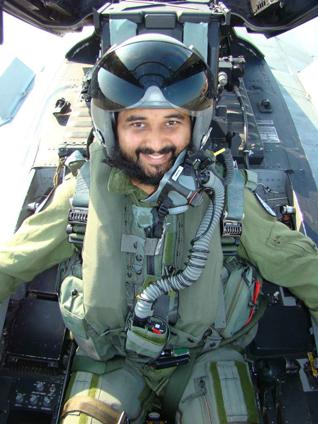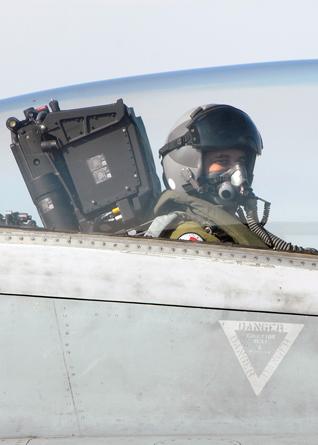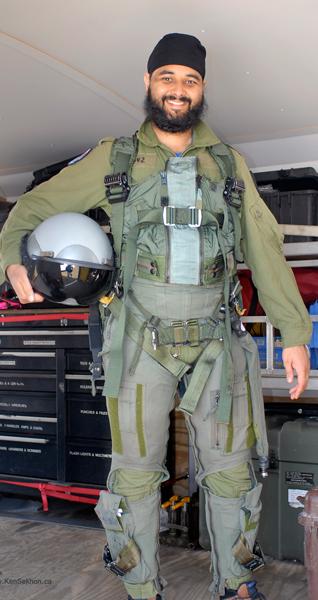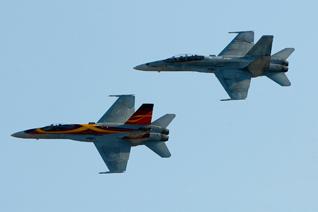People
Flying In a CF-18 Hornet
by JOETEY SINGH ATTARIWALA
I have had some exciting experiences as the Senior Writer and aviation specialist for the Canadian Defence Review, and although one cannot be compared to another, there is no doubt in my mind that my recent opportunity to fly in a 410 Squadron CF-18 Hornet fighter jet is a highlight that will be very difficult to top.
Not
only was this a first opportunity for me, but my flight also marked
a historical event for the Canadian Forces ("CF") as I now have the honour
to be the first turbaned Sikh-Canadian to fly in a CF-18 and, to the
best of our knowledge, any F-18 variant in the world.
Planning for the familiarization flight began months prior to the event, and consisted of paper work and authorizations being granted.
Since I am a Sikh, the issue of facial hair and a proper oxygen mask seal became a concern. It is a fact that bearded pilots fly high performance front line fighter jets in various air forces around the world. Canadian Forces flight safety rules exist for very good reasons. However, the basic truth is that the necessity to accommodate persons with facial hair has not arisen, nor has it been an issue until my flight was proposed.
Thankfully, the Canadian Forces is an organization accepting all faiths in service of our country, and indeed has personnel that embrace religious beliefs from around the world, including Sardars in various branches of the CF, however none as pilots.
Although I am a civilian, I
was subject to the same rules and regulations as service members; after
some discussions and with the support of Major-General Blondin at 1
Canadian Air Division, the concerns were addressed and a waiver was
issued for my flight.
My flight was to take place in Abbotsford, British Columbia. Upon arrival, I was greeted by members of the Canadian Forces CF-18 Demo Team. This year's demonstration pilot is Captain Erick O’Connor who is flying an aircraft from 409 Tactical Fighter Squadron.
The Demo team consists of a public affairs officer
from 1 Air Division, and Maintenance Support crew divided into two teams
from 3 and 4 Wings. This year's demonstration CF-18A is painted
in striking colors primarily focused around a yellow ribbon which is
wrapped around the canopy and flows aft over the dorsal spine of the
aircraft; the team’s theme is a salute to the families of service
members throughout the CF.
The first order of business was to have a physical conducted by a medical officer from 19 Wing.
This process consisted of a medical questionnaire to ensure no ailments or conditions which could preclude a flight, followed by diagnostic tests which are common in aerospace medicine. Once the medical was done, the process of outfitting me for flight began.
Fitting the flight suit was a simple eyeball match for size, followed by the more lengthy process of fitting me with an anti-G suit (commonly known as a G-suit or an anti-gravity suit). Every fighter pilot has flying gear fitted specifically to his/her body, so 4 Wing Maintenance and Support Crew took painstaking and meticulous effort to configure the nylon webbing of the G-suit to me.
After the G-suit was fitted, a harness and survival vest was next, part of which would serve to connect me to the ejection seat.
The whole flight suit fitting process took approximately 2 hours, the culmination of which was the helmet and the oxygen mask, various sizes of each were on hand for proper fitting. I already had a smaller turban on which would easily facilitate a flight helmet. When it came to the oxygen mask and the issue of my beard, I was very pleased to hear the 4 Wing Support team member comment on how good the seal was on me.
Once fully fitted, I was directed to a hangar where
my flight suit harness was connected to a hoist which lifted me off
the ground. This served to confirm proper fitting of the flight
gear, and allowed me the opportunity to learn how to disconnect from
a parachute if an ejection was necessary.
The pilot assigned to fly me
was Captain Dan Walters, an instructor pilot at 410 Squadron. Captain Walters focused my attention on the various procedures I would
need to do once I was strapped into the jet, and detailed the emergency
procedures I would have to remember if we needed to eject. Some
of these directions included adjusting the VOX (Voice Operated eXchange)
intercom, pulling safety pins, arming the ejection seat and more. The various commands, procedures and controls I was briefed on were
daunting to hear all at once, however things became clearer once seated
in the jet.
From the ground, the Hornet looks to have a spacious cockpit, however once strapped into the jet my perspective definitely changed. Since this was my first time strapped into a CF-18 with full flight gear, my range of motion was certainly more encumbered than a pilot that is used to a cockpit environment on a daily basis.
Once I had my intercom adjusted to speak with Captain Walters in the front seat, he asked if my hands were clear of the rails to have the canopy come down. Naturally there is sufficient room in the cockpit, however it is a snug fit and you certainly feel like you’re part of the jet.
I armed my ejection seat and tested the inflation of my G-suit.
As I was in a CF-18B, my portion of the cockpit was replete with full flight controls identical to the front seat, with the exception of a Heads-Up Display (HUD). For the rear seat in a CF-18B, the HUD information is replicated on one of the multi-function displays. Captain Walters executed a control surface washout where he verified that all control surfaces, speed brake and arresting hook were operating properly. Throughout this process, the 4 Wing Maintenance and Support team watched like hawks to verify everything was good-to-go for our flight.
I was extremely fortunate to be flying in a two-ship training flight along with the CF-18A Demo jet (Hornet 1) piloted by Captain O’Connor. Our flight plan was to demonstrate close-air support to ground forces.
Both our CF-18’s lined up on the runway with Captain O’Connor taking off first, and us following in quick succession in full afterburner.
The raw power I felt on takeoff was absolutely amazing and unlike anything I have ever experienced before. Within seconds we were airborne and following Hornet 1 over the lower mainland of British Columbia. We quickly joined up and did some formation flying. It was amazing to see another Hornet mere feet away from our jet. There is no doubt in my mind that CF pilots are highly professional and second to none.
Hornet 1 then separated and we conducted a line abreast ‘show of force’ manoeuvre by executing a high speed pass over a simulated target area. When Captain Walters would engage afterburner and tap the 32,000 lbs of thrust available from the Hornet’s engines, it literally pushed me back in the seat and put a huge smile on my face.
After the high speed pass, we established station and orbited above the target area. Upon the command of a forward air controller on the ground, we would aggressively roll in and execute simulated strafing and bombing runs. Feeling G’s on manoeuvring was something I was cautiously apprehensive about since I am aware of the amazing capabilities inherent in fighter jets.
The advice I received from Captain Joe Shetterly, a U.S. Air Force A-10 Warthog pilot prior to my flight was very helpful in mitigating the effects of G forces. We pulled over 5.5 G’s in many portions of our flight, and I’m pleased to say I didn’t vomit, grey-out, or lose consciousness as some do during such familiarization flights.
Once our numerous ingress and attack
manoeuvres were completed, Hornet 1 peeled off and returned to the airport.
Captain Walters and I continued on with my familiarization flight to demonstrate the capabilities of the Hornet. Once we had executed a number of manoeuvres, Captain Walters passed control of the jet to me. After flying countless military simulators, the chance to fly an upgraded Hornet is one I’ll never forget, nor will I ever forget Captain Walters words to me: "You’re flying a Hornet, man!"
I was amazed at the agility of
the Hornet and just how responsive it is; it was an experience unlike
any other. Our flight culminated in a smooth approach back to
Abbotsford airport. I was feeling fatigued, but totally appreciative
for the very rare opportunity extended to me.
By flying a turbaned Sikh-Canadian in a frontline fighter jet, the Royal Canadian Air Force can mark this event as another first in its distinguished history. This experience was of great significance to me professionally as Senior Writer for CDR, and as a matter of pride and personal reflection when I consider my grandfather who served as a Major in the British Indian Army, and other distinguished Sikhs who have served alongside Allied Forces throughout history, and those who serve in Canada today.
The following historical quote is now more poignant to me than ever before:
"In
the last two world wars 83,005 turban wearing Sikh soldiers were killed
and 109,045 were wounded. They all died or were wounded for the freedom
of Britain and the world, and during shell fire, with no other protection
but the turban, the symbol of their faith.” ... General Sir Frank Messervy.
I believe my flight is a symbolic gesture that speaks to the acceptance of all faiths, and is a symbol of acceptance of diversity within the Canadian Forces. My flight served as a clear demonstration of the excellent training our pilots and support crew receive, their unwavering professionalism, and the impressive capabilities of our CF-18 fighters.
I want to thank
Major-General Blondin, Captain Holly Brown, Captain Dan Walters, Captain
Erick O’Connor, and the 4 Wing Maintenance and Support Crew for their
kindness in making my flight in a Royal Canadian Air Force CF-18 Hornet
one I will never forget.
The author is a Senior Staff Writer and Aviation Specialist with the Canadian Defence Review Magazine, where this article first appeared.
Edited for sikhchic.com.
November 14, 2011
Conversation about this article
1: Sangat Singh (Kuala Lumpur, Malaysia), November 14, 2011, 9:14 AM.
A 'Reach for the Sky' indeed ... and may you go higher with Waheguru's Grace.
2: Baldev Singh (Bradford, United Kingdom), November 14, 2011, 5:44 PM.
Nice description of something only a few humans will ever experience! There are some super smart Sardar pilots who eschew publicity, but should have features done on them because it is an awesome profession.
3: Kuljit Kaur Jassal (Australia), November 14, 2011, 11:44 PM.
Thank you for the memories, Joetey ji. I had the opportunity to fly in a PC9 Trainer when I was posted as a Ground School Programmer to the RAAF's No. 2 Flying Training School in Western Australia. Like you, we pulled some Gs (4 for me) and I didn't throw up either ... something the ground staff commented upon when we landed. Reading this article just brought back a rush of memories for me ... I had the best time in the RAAF, working as a Logistics Officer (1988-2001).
4: Tejvinder Singh (Vancouver, British Columbia, Canada), September 28, 2013, 10:26 PM.
I like this article. Congratulations to you. I would like to ask you question about Sikh pilots in the Canadian air force. Is it possible to be fighter pilot with your full Sikhi saroop in the Canadian air force?
5: Mitch Savard (Calgary, Alberta, Canada), May 11, 2018, 3:12 PM.
I found your article out of curiosity about helmets and turbans. This seemed like an amazing experience, and a well written piece. Thank you for sharing your experience.






